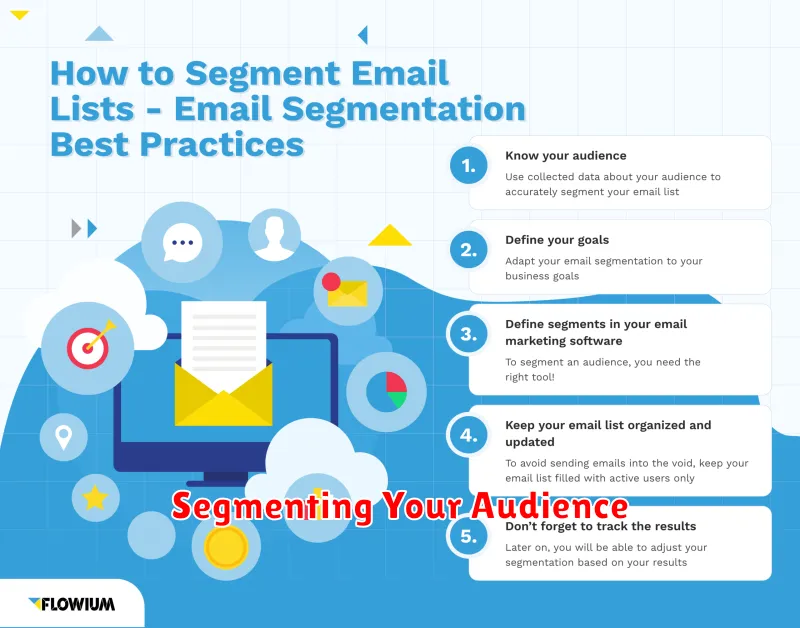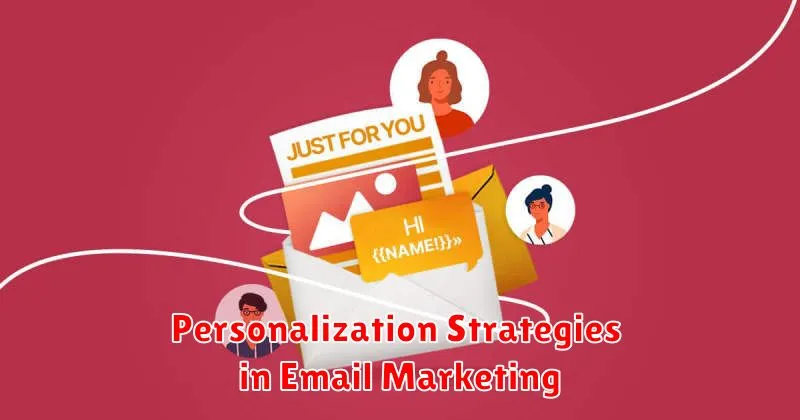In today’s competitive digital landscape, email marketing remains a powerful tool for reaching and engaging your target audience. However, generic email blasts are no longer effective. To truly maximize your return on investment, you need to embrace personalization strategies. Personalized email marketing allows you to tailor your messages to individual subscribers, delivering relevant content that resonates with their specific needs and interests. This intro will explore the importance of email personalization and how it can significantly improve your email marketing campaigns. By leveraging data and implementing the right tactics, you can create personalized email experiences that foster stronger customer relationships, drive conversions, and boost your bottom line.
This article will delve into various effective personalization strategies in email marketing, ranging from basic to advanced techniques. We will examine how leveraging data like demographics, past purchase behavior, and website activity can help you craft highly personalized emails. We will also discuss the importance of email segmentation, dynamic content, and behavioral targeting in creating a truly personalized customer journey. Implementing these personalization strategies will not only increase your open and click-through rates, but also contribute to higher conversion rates and improved customer lifetime value. Learn how to move beyond simple name insertion and truly personalize your email marketing strategy for optimal results.
The Power of Personalization
In today’s competitive digital landscape, email marketing remains a vital tool for businesses to connect with their audience. However, generic, one-size-fits-all email blasts are often ineffective. Personalization is the key to cutting through the noise and fostering meaningful engagement. By tailoring email content to individual subscribers, businesses can significantly enhance their marketing efforts and achieve better results.
Personalized emails demonstrate a genuine understanding of the recipient’s needs and preferences. This targeted approach leads to increased open rates, click-through rates, and ultimately, conversions. Addressing subscribers by name is a simple yet effective starting point. Further personalization can involve segmenting audiences based on demographics, purchase history, or website activity, and then crafting emails with content relevant to each segment.
Increased engagement is a direct outcome of personalization. When subscribers receive content tailored to their interests, they are more likely to interact with the email, explore the offered products or services, and make a purchase. This heightened engagement strengthens the customer relationship and builds brand loyalty. Beyond immediate conversions, personalized emails also contribute to long-term customer lifetime value.
Dynamic Content in Email
Dynamic content represents a significant advancement in email personalization. It goes beyond simply inserting a recipient’s name and delves into tailoring the email’s actual content based on individual characteristics and behaviors.
This approach allows marketers to send highly relevant emails that resonate more effectively with each recipient. Segmentation is key to dynamic content. By dividing your audience into distinct groups based on factors such as demographics, purchase history, or website activity, you can craft targeted messages that cater to specific interests.
For instance, a clothing retailer might showcase different product categories based on past purchases or browsing behavior. Someone who frequently buys men’s athletic wear would receive email content focused on new arrivals in that category, while a customer with a history of purchasing women’s dresses would see content related to dresses and other formal wear.
Dynamic content drives higher engagement and conversion rates because the information presented is directly relevant to the recipient’s needs and preferences. This enhanced relevance fosters a stronger connection with the brand and encourages desired actions, such as making a purchase or visiting the website.
Segmenting Your Audience

Segmentation is crucial for effective email personalization. It involves dividing your subscriber list into smaller, more homogenous groups based on shared characteristics. This allows you to tailor your messaging to resonate with each segment’s specific needs and interests, resulting in higher engagement and conversion rates.
Several factors can be used for segmentation. Demographics such as age, gender, and location provide a basic understanding of your audience. Behavioral data, including past purchases, website activity, and email engagement, offers insights into individual preferences and habits. Psychographics, encompassing values, interests, and lifestyle, delve deeper into what motivates your subscribers.
Effective segmentation requires a strategic approach. Start by identifying your key marketing goals. Then, determine which data points are most relevant to achieving those goals. Finally, use your email marketing platform’s segmentation tools to create dynamic segments that automatically update as new information becomes available.
Here are a few segmentation examples:
- New subscribers vs. loyal customers
- High-value customers vs. low-value customers
- Customers interested in product A vs. product B
By segmenting your audience, you can deliver more relevant and targeted emails, fostering stronger customer relationships and driving better results.
Using Behavior Triggers
Behavior triggers are a powerful personalization tactic in email marketing, sending targeted messages based on subscribers’ specific actions. This allows for timely and relevant communication, increasing engagement and conversions.
Welcome emails are a classic example, triggered when a user signs up for a newsletter or creates an account. This is a prime opportunity to make a strong first impression and set expectations for future communication.
Abandoned cart emails target users who add items to their online shopping cart but leave without completing the purchase. These emails serve as a gentle reminder and often include incentives, such as free shipping or discounts, to encourage the customer to return and finalize the transaction.
Browse abandonment emails are sent to users who view specific products or categories on a website but don’t add them to their cart. These emails can showcase related items or offer personalized recommendations based on browsing history.
Post-purchase emails follow up after a customer completes a purchase. These emails can be used to thank the customer, request feedback, offer product recommendations, or promote related products and services. Transactional emails, such as order confirmations and shipping updates, also fall under this category.
Name and Location Tags
Using name and location tags within your email marketing campaigns allows for a deeper level of personalization, fostering a stronger connection with your recipients. Name personalization, including first name, last name, or preferred name, goes beyond simply addressing the email. It can be integrated into the body of the message for a more tailored feel.
Location tags enable you to send location-specific content, such as highlighting local events, promotions, or store information relevant to the recipient’s geographic area. This targeted approach enhances relevance and engagement, as subscribers receive information pertinent to their current location. This data can often be gleaned from sign-up forms or website activity.
Employing these tags strategically strengthens your email campaign’s overall effectiveness by delivering personalized content that resonates with each individual subscriber. This leads to increased open rates, click-through rates, and ultimately, conversions.
Automation Tools for Personalization
Leveraging the right automation tools is crucial for effective email personalization. These tools empower marketers to collect and analyze customer data, segment audiences, and deliver dynamic content. Choosing the right tool depends on factors like budget, technical expertise, and integration needs with existing systems.
Several categories of tools exist to support personalization initiatives. Customer Relationship Management (CRM) systems are foundational, providing a central hub for customer data. Email marketing platforms offer built-in features for automation, segmentation, and personalized content delivery. Data analytics platforms provide deeper insights into customer behavior and preferences.
Specific features to look for include dynamic content insertion, allowing for tailored messaging within emails based on customer attributes. Behavioral triggering enables automated email sends based on actions like website visits or purchases. A/B testing capabilities facilitate optimizing email content for maximum impact.
By strategically implementing automation tools, marketers can streamline their personalization efforts, achieving greater efficiency and enhanced customer engagement.
Measuring Impact of Personal Emails
Measuring the effectiveness of personalized emails requires focusing on key metrics that demonstrate engagement and conversion. Open rates, while a starting point, are less indicative of true impact than click-through rates (CTR). CTR reveals how compelling personalized content is in driving recipients to take action.
Conversion rates are paramount. This measures how effectively personalized messaging influences desired outcomes, such as purchases, sign-ups, or downloads. Tracking conversions tied to specific personalization tactics provides valuable insight into what resonates with the audience.
Beyond these core metrics, analyze transaction value and customer lifetime value (CLTV). Personalized emails can influence not only the number of transactions but also the amount spent per transaction and the long-term value of a customer. Monitoring these metrics illuminates the return on investment (ROI) of personalization efforts.
Finally, gather qualitative data through surveys and feedback forms. Directly asking recipients about their experience with personalized emails can provide invaluable insights into preferences and areas for improvement. This data complements quantitative metrics to offer a comprehensive understanding of personalization’s impact.
Common Pitfalls to Avoid
While personalization can significantly enhance email marketing, several pitfalls can hinder its effectiveness. One common mistake is over-personalization, which can feel intrusive or creepy. Using too much personal data can make recipients uncomfortable, leading them to unsubscribe.
Another pitfall is inaccurate data. Typos in names or incorrect demographics undermine your credibility and make the personalization seem insincere. Ensure your data is clean, accurate, and up-to-date through regular verification and updates.
Ignoring segmentation is also detrimental. While personalization focuses on the individual, segmentation groups similar individuals based on shared characteristics. Failing to segment your audience can lead to irrelevant messaging, diminishing engagement.
Finally, neglecting testing and optimization is a crucial oversight. A/B test different personalization tactics to understand what resonates with your audience. Monitor key metrics like open rates, click-through rates, and conversions to continuously refine your approach and maximize impact.
Real-World Campaign Examples
Examining real-world examples can illuminate the practical application of personalized email marketing. Amazon, for instance, leverages browsing history and past purchases to recommend relevant products via email. These recommendations are dynamically inserted into email templates, creating a personalized experience for each recipient.
Another example is Netflix, which utilizes viewing habits to suggest movies and TV shows that align with individual preferences. They often incorporate personalized thumbnails and subject lines, further enhancing engagement. This data-driven approach ensures that subscribers receive targeted recommendations, increasing the likelihood of continued subscriptions.
Spotify uses listening history to curate personalized playlists and recommend new artists. These personalized playlists are then promoted through email campaigns, strengthening user engagement and fostering brand loyalty. This strategy effectively leverages user data to provide a tailored experience, encouraging continued platform usage.
Improving Open and Click Rates
Open and click rates are crucial metrics for gauging email marketing success. Several strategies can significantly improve these metrics. A compelling subject line is the first step. It should be concise, personalized, and create a sense of urgency or curiosity.
Personalization extends beyond the subject line. Tailoring email content to individual subscriber preferences based on past behavior, demographics, or purchase history leads to higher engagement. Segmenting your audience allows for more targeted messaging, increasing relevance and the likelihood of opens and clicks.
Send times also play a significant role. Optimizing send times based on when subscribers are most active can dramatically improve open rates. A/B testing different send times can help determine the optimal window for your audience.
Mobile optimization is essential. A majority of emails are opened on mobile devices. Ensure your emails are responsive and render correctly on various screen sizes for a seamless user experience, encouraging clicks.
Finally, a clear and concise call to action is vital. Make it easy for subscribers to take the desired action with a prominent and compelling call to action button.

